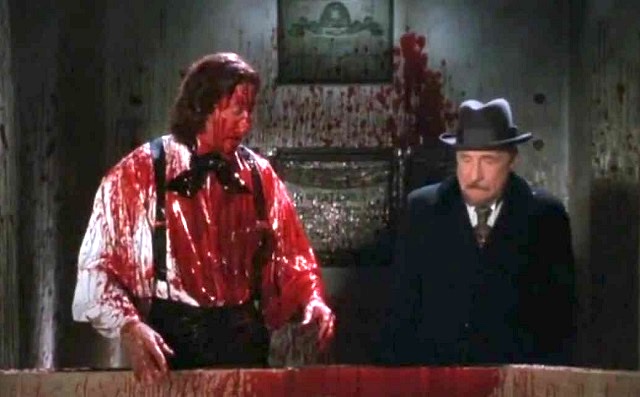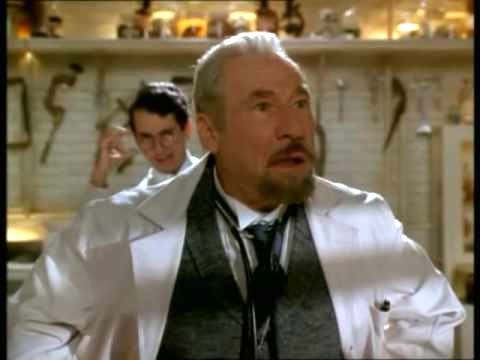Dracula Dead and Loving It (1995) starring Leslie Nielsen, Steven Weber, Peter MacNicol, Lysette Anthony, Mel Brooks
I’ve been doing reviews of various movies with Harvey Korman, since his recent death. This led me to watch Dracula: Dead and Loving It starring Leslie Nielsen, Steven Weber, Peter MacNicol and Lysette Anthony. Most of the reviews that I’d read led me to believe that it was a very unfunny movie, with only one or two laughs during the entire movie. In my opinion, they were totally wrong–I would describe this as Mel Brooks’ most underrated movie.
![]() Dracula: Dead and Loving It is a spoof of the vampire movie genre. It spoofs the original Dracula movie, the Hammer series of Dracula movies and several more recent Dracula movies as well. It’s chock full of funny moments–especially if you’ve seen those previous movies, which I have. If you haven’t, some of the jokes will go straight over your head. Regardless, much of the movie is very funny — slapstick and outrageous situations abound. Examples include :
Dracula: Dead and Loving It is a spoof of the vampire movie genre. It spoofs the original Dracula movie, the Hammer series of Dracula movies and several more recent Dracula movies as well. It’s chock full of funny moments–especially if you’ve seen those previous movies, which I have. If you haven’t, some of the jokes will go straight over your head. Regardless, much of the movie is very funny — slapstick and outrageous situations abound. Examples include :
- Dracula rising from his coffin, only to hit his head on a chandelier
- a funny scene with Renfield ineptly trying to secure Dracula’s coffin from sliding back and forth across the floor during a rough sea passage,
- and a side-splitting interview between Harvey Korman (amazingly, and amusingly, subdued) and Renfield (played absolutely brilliantly by Peter MacNicol). Renfield is eating insects at a tea, trying to persuade Harvey Korman’s character that he’s perfectly all right.
Another scene that I really enjoyed was Mel Brooks, playing Dracula’s nemesis Professor Van Helsing, as he teaches an anatomy class, having his students faint one-by-one as he intentionally grosses them out–if anyone remembers the opening to the Quincy TV series, they’ll smile twice as much at this scene.
Conclusion
So, having said all of this, do I recommend the film? Unfortunately not. As is Mel Brooks’ wont, he goes for the vulgar. Virtually every woman in the film has cleavage threatening to pop out of her dress. There are several moments that I would be embarrassed to watch with my wife. It would be inconceivable to watch with my children. A real pity.
Cast of characters





- Leslie Nielsen (Forbidden Planet, An American Carol) … Dracula
- Peter MacNicol (Bean the Movie) … Renfield
- Steven Weber (Wings, The Shining) … Harker
- Amy Yasbeck (The Mask, Robin Hood: Men in Tights) … Mina
- Lysette Anthony (The Emperor’s New Clothes, Krull) … Lucy
- Harvey Korman (The Longshot, The Carol Burnett Show) … Dr. Seward
- Mel Brooks (Spaceballs) … Professor Van Helsing
- Mark Blankfield … Martin
- Megan Cavanagh … Essie
- Clive Revill (Avanti!) … Sykes
- Chuck McCann (Silent Movie) … Innkeeper
- Avery Schreiber (Don’t Drink the Water) … Peasant on Coach
- Charlie Callas (The Big Mouth) … Man in Straitjacket
- Anne Bancroft (The Miracle Worker) … Gypsy Woman
Editorial review of Dracula : Dead and Loving It, courtesy of Amazon.com
In 1995, it was promising to hear that Mel Brooks was creating “the companion piece to Young Frankenstein.” He had also brought in the heavyweight of deadpan–Leslie Nielsen. As Lt. Frank Drebin in the Police Squad movies, Nielsen has no peer for silly stuff–just the player Brooks would seem to need for a strong movie, as any fan of Brooks perpetually hopes a new film may rekindle his madcap magic.
Alas, the end results in Dracula: Dead and Loving It include a sprinkling of amusements and one big belly laugh. Brooks and his writers use a very tight adaptation of Bram Stoker’s novel, but the spoofs can be spelled out as we go, as if they are paint-by-number. Some are jabs at Coppola’s version of Dracula, but most are attached to classic Dracula films.
If any real pleasure comes from the movie it’s thanks to the efforts of the cast. Peter MacNicol plays the crazed Renfield to the letter, Steven Weber has a good time as the tight British Harkin, and Lysette Anthony charms as the doomed Lucy. Brooks and Nielsen ham it up just fine. There’s even a surprisingly controlled performance by Harvey Korman (a character spoofing Anthony Hopkins’s role in the misfire The Road to Wellville). As with Brooks’s period comedies, the film looks better than it needs to and includes a few tricky special effects for good measure. This has nothing to do with the audience laughing–we need bigger jokes. And when you double over laughing in one scene–involving a stake through the heart and a bucket of blood–you want the movie to achieve Brooks’s days of glory, when hearty laughter was the norm, not an isolated moment. –Doug Thomas


